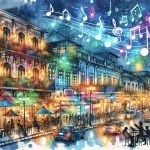Bourbon Street, the pulsating heart of New Orleans’ French Quarter, has captivated visitors for centuries with its unparalleled energy. This iconic 13-block thoroughfare, stretching from Canal Street to Esplanade Avenue, is a melting pot of history, culture, and revelry, drawing over 17 million visitors annually. Bourbon Street has become synonymous with the city’s legendary nightlife and unique spirit.
In This Article
TL;DR
- Bourbon Street offers a vibrant nightlife scene renowned worldwide.
- The street boasts a rich cultural heritage and historical significance dating back to New Orleans‘ founding.
- Visitors can enjoy historic bars, live music venues, diverse dining options, and annual festivals.
Historical Overview of Bourbon Street
Named after the French royal family, not the whiskey, Bourbon Street dates back to the city’s founding in 1718. As New Orleans grew, the street evolved from a residential area to a thriving entertainment hub, with the opening of the famous Absinthe House in 1874.
Bourbon Street’s transformation was shaped by historic events like the Louisiana Purchase, the Civil War, and the rise of jazz music in the early 20th century. The street became a symbol of the city’s resilience, continuously attracting visitors and adapting to changing times.
Architectural Highlights
A stroll along Bourbon Street reveals a stunning array of architectural styles, from colorful Creole cottages to grand Victorian mansions, many meticulously preserved, offering a glimpse into the city’s rich past.
One notable example is the Old Absinthe House (240 Bourbon St), built in 1806 as a family-owned importing firm. Its iconic copper-topped wooden bar and decorative marble fountains have witnessed countless patrons, including President Franklin Roosevelt and the pirate Jean Lafitte.
Another architectural gem is the Royal Sonesta Hotel (300 Bourbon St), which opened in 1969 but occupies a site dating back to the city’s founding. The hotel’s exterior was designed to resemble a typical 1830s row of houses, seamlessly blending with the street’s historic character.
Cultural Tapestry
Bourbon Street’s vibrant atmosphere reflects the diverse cultural influences that have shaped New Orleans, from French and Spanish colonial roots to African and Caribbean traditions. This rich tapestry is evident in the street’s music, cuisine, and festivals.
As the birthplace of jazz, New Orleans’ musical legacy is celebrated in the numerous live music venues lining Bourbon Street. Fritzel’s European Jazz Club (733 Bourbon St) hosts traditional jazz performances nightly in a nearly 200-year-old building.
Annual events like Mardi Gras and the Southern Decadence Festival showcase the street’s festive spirit and LGBTQ+ inclusivity. During these celebrations, Bourbon Street comes alive with colorful parades, elaborate costumes, and non-stop entertainment.
Nightlife and Entertainment
Bourbon Street’s nightlife scene is unparalleled, offering an eclectic mix of bars, clubs, and music venues catering to every taste. Visitors can enjoy classic New Orleans cocktails like the Hurricane or Sazerac, sing karaoke, or dance the night away to live music.
One must-visit spot is Lafitte’s Blacksmith Shop (941 Bourbon St), reputed to be the oldest structure used as a bar in the United States. The candlelit tavern, built between 1722 and 1732, is named after the infamous pirate Jean Lafitte and offers a glimpse into the city’s storied past.
For a lively atmosphere and diverse music lineup, head to The Cats Meow (701 Bourbon St), a karaoke club that has welcomed celebrities like Miley Cyrus and Bon Jovi. Open daily from 12 pm to 4 am, the club features a balcony overlooking the street and no cover charge.
Culinary Experience on Bourbon Street
No visit to Bourbon Street is complete without sampling the mouthwatering Creole and Cajun cuisine that New Orleans is famous for. From classic dishes like gumbo and jambalaya to po’boys and beignets, the street offers a culinary adventure for every palate.
For an upscale dining experience, Galatoire’s Restaurant (209 Bourbon St) has been a French Quarter institution since 1905. The restaurant is known for its impeccable service, classic French Creole dishes, and lively Friday lunch tradition. Signature dishes include Shrimp Remoulade, Crabmeat Maison, and Oysters Rockefeller.
For a more casual bite, stop by Desire Oyster Bar (300 Bourbon St) in the Royal Sonesta Hotel. The restaurant offers fresh Gulf oysters, shucked to order, as well as classic New Orleans dishes like Oysters Bienville and Shrimp Étouffée. Open daily from 11:30 am to 10 pm.
Safety and Navigation Tips
While Bourbon Street’s lively atmosphere is part of its charm, it’s essential to prioritize safety and be aware of local laws and regulations. Some best practices for enjoying a safe night out include:
- Stick to well-lit, populated areas and avoid walking alone late at night
- Keep valuables secure and be mindful of pickpockets in crowded areas
- Pace yourself when consuming alcohol and stay hydrated with water
- Be aware of open container laws – alcoholic beverages must be in a plastic “go-cup” when taken outside of bars
During peak times like Mardi Gras or Halloween, expect larger crowds and potential street closures. Plan ahead, arrive early, and be prepared for slower navigation.
Economic Impact and Future Outlook
Bourbon Street’s popularity has a significant impact on New Orleans’ economy, with the tourism industry accounting for nearly 40% of the city’s operating budget. The street’s businesses, including bars, restaurants, and souvenir shops, contribute to the city’s vibrant commerce and job market.
As trends in tourism and business development evolve, Bourbon Street continues to adapt while preserving its unique character. Future projects, such as the proposed pedestrianization of the street, aim to enhance the visitor experience and ensure the street remains a vital part of New Orleans’ cultural landscape for generations to come.
Visitor Information
When planning a visit to Bourbon Street, consider the following practical tips:
- The best times to visit depend on your preferences – weekends and holidays tend to be busier, while weekdays offer a more laid-back experience
- Many bars and clubs are open 24/7, but peak hours are typically from 8 pm to 3 am
- Parking can be challenging, so consider using public transportation, rideshares, or walking from nearby hotels
- Accommodation options range from budget-friendly hostels to luxurious hotels, many within walking distance of Bourbon Street
For more information on specific attractions and venues, consult their official websites or contact them directly:
Fritzel’s European Jazz Club: 733 Bourbon St, (504) 586-4800
Lafitte’s Blacksmith Shop: 941 Bourbon St, (504) 593-9761
The Cats Meow: 701 Bourbon St, (504) 523-2788
Galatoire’s Restaurant: 209 Bourbon St, (504) 525-2021
Desire Oyster Bar: 300 Bourbon St, (504) 553-2281
Bourbon Street’s enduring appeal lies in its ability to captivate visitors with its rich history, vibrant culture, and non-stop entertainment. Whether you’re a first-time visitor or a seasoned reveler, this iconic destination promises an unforgettable experience in the heart of New Orleans. So grab a go-cup, follow the sound of jazz, and let the good times roll on Bourbon Street.






